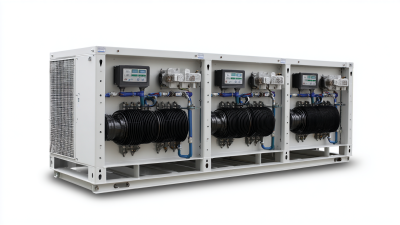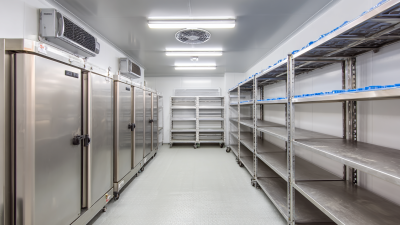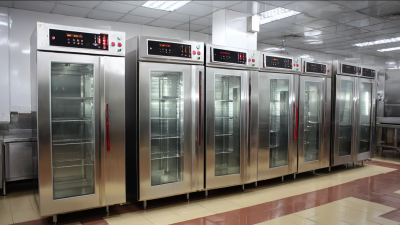How to Optimize Your Instructional Cold Room Unit for Maximum Efficiency and Performance
Table of Contents
- Analyzing Energy Consumption Patterns in Cold Room Units
- Evaluating the Importance of Temperature and Humidity Control
- Implementing Regular Maintenance Schedules for Optimal Performance
- Upgrading Insulation and Sealing to Enhance Efficiency
- Choosing the Right Equipment for Specific Instructional Needs
- Training Staff on Best Practices for Cold Room Usage
- Revolutionizing Cold Storage: Insights from Industry Reports on Refrigeration Unit Compressors for Enhanced Efficiency
- FAQS
- Conclusion
- Related Posts
When it comes to temperature-sensitive storage, fine-tuning your Instructional Cold Room Unit is pretty much essential for a bunch of industries—think food and beverages, pharma, or biotech. I mean, industry reports suggest that the global cold storage market is expected to hit around USD 275.79 billion by 2027, with a solid growth rate of about 12.1% annually. That just shows how much demand there is for really efficient refrigeration solutions these days. Here at Guangxi Cooler Refrigeration Equipment Co., Ltd., we really get how important high-performance cold storage systems are—not just for ticking all the regulatory boxes but also for making your operations run smoother. That’s why we offer a full, one-stop shop for cold storage, covering everything from planning and design to supplying the right equipment. We aim to make your buying experience as hassle-free as possible, all while tailoring solutions to fit your specific needs. By optimizing your Instructional Cold Room Unit, you’ll not only save energy and cut costs, but you’ll also get a longer-lasting setup. It’s all about helping your business stay sustainable and efficient in the long run.

Analyzing Energy Consumption Patterns in Cold Room Units
When it comes to optimizing cold room units in your facility, really getting a handle on energy use is a game-changer. Recent studies show that cold storage can make up about 10-15% of a typical grocery store’s total energy bills—that’s no small chunk of change! So, by taking a close look at things like outside temperature, humidity, and how busy the place is, managers can spot where things aren’t running as efficiently as they could be. For example, the U.S. Department of Energy has found that upgrading insulation and using energy-efficient compressors in cold rooms can cut energy use by up to 30%. Pretty impressive, right?
And here’s a thing that’s really making a difference: smart energy management systems. These tech setups can monitor and tweak the cooling in real-time based on what's needed at the moment, leading to even more savings. There’s research in the International Journal of Refrigeration that confirms this—by adjusting settings on the fly, these systems not only save energy but also help keep products fresh and prevent equipment from breaking down prematurely. Knowing when energy use peaks and maintaining stable temperatures isn’t just about saving money—it’s about keeping your operation smooth and your products safe. Focus on these areas, and you’ll see improvements not just in energy efficiency but also in the overall performance of your cold storage setup.
Evaluating the Importance of Temperature and Humidity Control
Keeping the right temperature and humidity levels in those instructional cold rooms really matters if you want to get the best performance and efficiency. Recent breakthroughs in atmospheric research, especially when it comes to spotting nitrogen compounds, just go to show how important it is to have tight control over the environment. When you regulate temperature and humidity well, it makes a big difference—especially for sensitive materials stored inside. It helps ensure they stay in good shape and actually work when needed.
On top of that, we've been seeing some pretty cool innovations in humidity control tech. Think about smart humidifiers or high-tech MEMS speakers—they’re perfect examples of how the demand for good humidity management isn't just for industrial stuff anymore, it’s creeping into daily life too. If we start using these kinds of technologies in cold room units, I bet it could make managing things a whole lot easier. Plus, it'd probably save energy and keep those materials in tip-top shape longer. Honestly, it's all about making things run smoother and more efficiently—pretty exciting, huh?
Implementing Regular Maintenance Schedules for Optimal Performance
Keeping up with regular maintenance for your instructional cold room is really key to making sure it runs smoothly. Think of it as giving the equipment a quick check-up every now and then—things like the cooling system and temperature controls need to be in top shape. It's a good idea to set up routine inspections to spot any wear and tear early on, and double-check that the temperature settings are accurate because that’s super important for keeping the right environment. Don’t forget to clean those air filters and condenser coils regularly too—trust me, it can really boost energy efficiency and save you some money in the long run.
Making these checks a regular habit not only helps your equipment last longer but also cuts down on surprise breakdowns. Keeping a simple log of what you do can really help spot patterns or trouble spots before they become big issues. Plus, getting your team involved in the maintenance tasks can raise awareness and make everyone more responsible for keeping things running smoothly. When everyone cares about the cold room, it’s a win-win—it works better, and it ensures a smooth experience for everyone using it, especially students or staff relying on that perfect climate environment.
Optimizing Instructional Cold Room Unit Performance
This chart illustrates the impact of regular maintenance on the efficiency of instructional cold room units over a period of six months. The data reflects the monthly efficiency rating on a scale of 0 to 100 based on maintenance activities performed.
Upgrading Insulation and Sealing to Enhance Efficiency
Upgrading the insulation and sealing in your cold storage unit is pretty much key if you want to get the most out of it, energy-wise and performance-wise. I mean, did you know the global polyurethane spray foam market's expected to jump from around $3 billion in 2025 to nearly $4.8 billion by 2032? That just shows how much folks are really into better insulation options these days. Spray foam insulation, in particular, is praised for its incredible energy-saving abilities — it creates an airtight barrier that cuts down on thermal leaks and helps lower your energy bills. Not only does it boost the overall energy efficiency of your cold rooms, but it also helps keep the temp and humidity just right — super important if you're storing sensitive stuff.
And get this — the broader insulation market is also poised for some serious growth, expected to hit over $128 billion by 2034. That’s mainly because more companies are getting into eco-friendly building practices and embracing new materials. If you're serious about saving energy and cutting costs, investing in top-notch insulation and sealing really becomes a no-brainer. By dialing in these upgrades on your cold storage units, you’re not just saving some bucks now but also stepping up your game in sustainability. It’s a win-win — better performance, less waste, and a little boost towards being greener overall.

Choosing the Right Equipment for Specific Instructional Needs
Picking the right equipment for your instructional cold room isn't just a detail—it's key to making sure everything runs smoothly and efficiently. Depending on what you’re teaching—maybe culinary arts, biology classes, or food service training—you'll want solutions that are tailored to those needs. For example, if you're focusing on culinary education, it’s really important to have refrigerators and freezers that are easy to access and keep a steady temperature. Features like adjustable shelves and transparent doors can make a big difference—they help with organization and let students see what's inside easily, making the hands-on learning experience much better.
On the flip side, if your main focus is biological sciences, then you’ll probably need equipment like precise incubators or specialized refrigerators for storing specimens. These should have super accurate temperature controls and good monitoring systems so sensitive samples stay safe and intact. Also, it’s worth looking into energy-efficient models—not just to cut down on costs but also as a part of a bigger plan to go green and be more sustainable in educational settings.
When you pick equipment that really fits your teaching needs, it can seriously boost the learning experience and help promote best practices in the field. Bottom line: choosing thoughtfully makes all the difference!
Training Staff on Best Practices for Cold Room Usage
 Training staff on the best ways to use cold rooms is super important if you want these units to work at their best. First off, everyone really needs to understand the specific temperature needs for different materials, since not everything’s stored the same way. This training should cover how to keep an eye on the temperature, make sure the door seals are tight, and avoid big temperature swings that could mess up stored items. It’s these little things that matter!
Training staff on the best ways to use cold rooms is super important if you want these units to work at their best. First off, everyone really needs to understand the specific temperature needs for different materials, since not everything’s stored the same way. This training should cover how to keep an eye on the temperature, make sure the door seals are tight, and avoid big temperature swings that could mess up stored items. It’s these little things that matter!
Plus, staff should know the ins and outs of organizing and labeling everything inside the cold room. Storing stuff properly not only saves space but also makes it way easier to find things quickly, so folks aren’t opening the door more than needed. Regular training sessions are a great idea—they give team members a chance to share tips, troubleshoot issues, and feel more confident. When everyone’s on the same page about these best practices, it really boosts how well the cold rooms perform overall. So, investing in proper training isn’t just a good idea—it’s kinda essential for keeping things running smoothly and efficiently.
Revolutionizing Cold Storage: Insights from Industry Reports on Refrigeration Unit Compressors for Enhanced Efficiency
Revolutionizing cold storage through advanced refrigeration unit compressors is crucial for maintaining the integrity of temperature-sensitive goods. In the commercial refrigeration sector, these compressors play a vital role in ensuring that fresh produce remains available throughout the year, regardless of external weather conditions. According to industry reports, the efficiency of refrigeration compressors has seen significant improvements, leading to reduced energy consumption and lower operational costs for businesses. For instance, modern scroll compressors can achieve energy efficiency ratios (EER) exceeding 3.0, representing a substantial leap from older models.
Gungxi cooler products exemplify the advancements in compressor technology that enhance cooling chain reliability. By utilizing state-of-the-art refrigeration compressors, Gungxi ensures that temperature-sensitive goods maintain their quality and shelf life during transportation and storage. Reports indicate that proper temperature management can reduce spoilage rates by up to 30%, highlighting the importance of reliable refrigeration systems in the food supply chain. Industry experts recommend that businesses invest in high-efficiency compressors to not only ensure product quality but also to contribute to sustainability by minimizing energy use and waste.
Furthermore, with increasing regulatory scrutiny on food safety standards, relying on advanced refrigeration solutions has become more than a choice; it is a necessity. The ability to maintain a consistent temperature throughout the storage and distribution process directly impacts food safety, making the selection of refrigerant compressors an essential consideration for companies that prioritize quality and compliance. As the market evolves, investing in innovative compressor technologies like those offered by Gungxi is a strategic move towards enhancing efficiency in cold storage operations.
FAQS
: Maintaining optimal temperature and humidity levels is crucial for maximizing efficiency and performance, especially for sensitive materials stored in these units. It ensures their integrity and applicability.
Recent advances in atmospheric research, specifically in the detection of nitrogen compounds, underscore the importance of precise environmental control for enhancing performance in cold room units.
Innovations, such as smart humidifiers and high-performance MEMS speakers, demonstrate the growing demand for effective humidity management systems that not only optimize industrial applications but also improve everyday use.
For culinary education, it’s essential to select refrigerators and freezers with easy access, consistent temperatures, adjustable shelving, and transparent doors to promote organization and visibility for hands-on learning.
Students focusing on biological sciences may require controlled temperature incubators or specialized refrigerators for specimens, which provide precise temperature control and reliable monitoring systems.
Energy-efficient models help reduce operational costs and align with sustainability goals in educational settings, promoting best practices while enhancing the overall education experience.
Implementing advanced humidity management technologies can lead to considerable improvements in management and operational efficiency, aiding in better material preservation and reducing energy costs.
Optimal equipment selection should align with specific instructional purposes, catering to the unique needs of different educational settings, ultimately enhancing the learning experience.
Conclusion
If you're looking to get the most out of your instructional cold room units, the article 'How to Optimize Your Instructional Cold Room Unit for Maximum Efficiency and Performance' is pretty much a must-read. It offers a solid overview of how to boost the effectiveness of these cold storage setups, especially in educational or instructional settings. One thing it really highlights is the importance of keeping an eye on energy usage—like, understanding when and where you're using the most power can help you spot chances to improve.
Proper temperature and humidity control? Absolutely crucial. It’s key for keeping your stored materials in good shape. The article also suggests sticking to a regular maintenance routine, upgrading insulation and seals when needed, and making sure you're choosing equipment that’s actually suited to your specific needs.
Training your staff on how to properly use and maintain the cold room is another smart move—it makes sure everything runs smoothly and efficiently. Plus, with the expert support of Guangxi Cooler Refrigeration Equipment Co., Ltd., any institution can get custom solutions for planning, designing, and equipping their cold storage spaces.
Follow these tips, and you’ll not only make smarter purchases but also get a lot more reliable, hassle-free performance from your instructional cold room. It’s all about making things simpler and more effective in the long run.
Related Posts
-

Ultimate Showdown of Monoblock Refrigeration Units Performance and Efficiency
-

7 Essential Tips for Maximizing Efficiency in Your Freezer Cold Room
-

What is the Impact of Cold Room and Freezer Manufacturers on Food Preservation Efficiency
-

5 Best Commercial Refrigeration Equipment Manufacturers for Your Business Success
-

Top Strategies for Sourcing High Quality Freezer Compressors Globally
-

Mastering the Setup: A Comprehensive Guide to Installing Condensing Unit Cold Rooms
Blog Tags:


